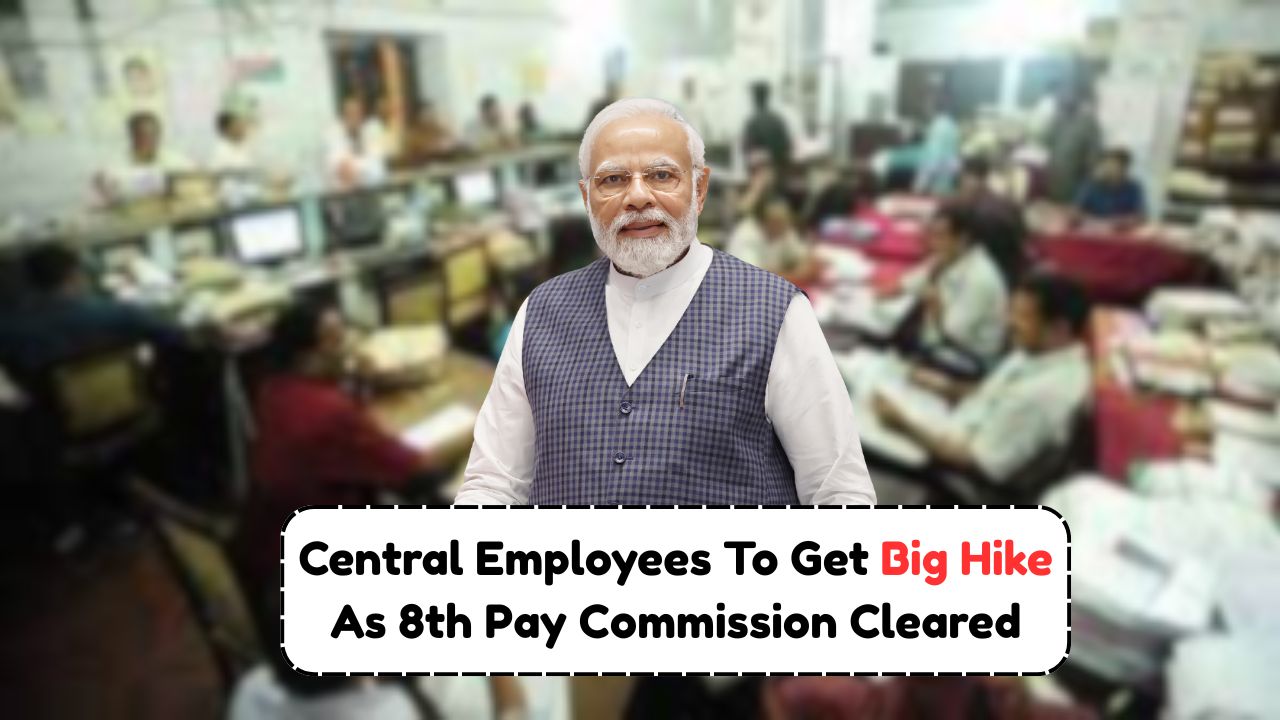8th Pay Commission – The Central Government has officially greenlit the formation of the 8th Pay Commission, setting the stage for a significant increase in salaries, pensions, and dearness allowance (DA) rates for millions of central government employees and pensioners. The implementation is expected to coincide with the Union Budget 2026, bringing long-awaited financial relief and upliftment to the salaried and retired workforce. This landmark move will impact over 50 lakh central government employees and 65 lakh pensioners across India. With rising inflation and economic adjustments, this decision comes as a welcome move for the middle class and salaried segments who have been awaiting revision since the 7th Pay Commission was introduced in 2016.
8th Pay Commission: What Has Been Approved?
The Union Cabinet has approved the constitution of the 8th Pay Commission to recommend revised pay structures for central government employees. The new pay structure will aim to address inflation concerns, reduce pay disparities, and offer a performance-linked incentive mechanism.
Key Features of the 8th Pay Commission:
- Effective from Union Budget 2026 (implementation likely from 1 July 2026)
- Minimum salary expected to increase from ₹18,000 to ₹26,000
- Revised DA calculation formula to be introduced
- Pension slabs to be revised upward by at least 30%
- Fitment factor likely to increase from 2.57x to 3.68x
- Separate allowances review for defence personnel and paramilitary forces
- Recommendations to be submitted by mid-2025
Expected Changes in Basic Pay Structure
The 8th Pay Commission will bring a substantial increase in the basic salary of central government employees. Based on early discussions and expectations, here’s a projected comparison between the 7th and 8th CPC salaries.
Projected Salary Table (7th CPC vs 8th CPC)
| Pay Level | Existing Basic (7th CPC) | Expected Basic (8th CPC) | Estimated Hike | Fitment Factor |
|---|---|---|---|---|
| Level 1 | ₹18,000 | ₹26,000 | ₹8,000 | 3.68x |
| Level 2 | ₹19,900 | ₹28,000 | ₹8,100 | 3.68x |
| Level 3 | ₹21,700 | ₹30,500 | ₹8,800 | 3.68x |
| Level 4 | ₹25,500 | ₹35,000 | ₹9,500 | 3.68x |
| Level 5 | ₹29,200 | ₹40,000 | ₹10,800 | 3.68x |
| Level 6 | ₹35,400 | ₹48,000 | ₹12,600 | 3.68x |
| Level 7 | ₹44,900 | ₹61,000 | ₹16,100 | 3.68x |
| Level 8 | ₹47,600 | ₹64,000 | ₹16,400 | 3.68x |
Dearness Allowance (DA) Revision under 8th CPC
One of the major attractions of the new pay commission is the change in the Dearness Allowance structure. The government plans to revise the DA calculation mechanism to better reflect the rising cost of living.
Proposed DA Framework:
- DA to be merged with basic pay at 50% threshold (as per 6-month review rule)
- New base year for CPI index calculation under review
- DA likely to start from 0% under 8th CPC starting July 2026
- More dynamic adjustments every 6 months based on inflation trends
This new mechanism will prevent DA arrears from piling up and ensure faster monetary adjustments for employees.
Pension Revision and Benefits for Retirees
The 8th Pay Commission is expected to substantially uplift pension slabs, bringing joy to over 65 lakh central government pensioners.
Projected Pension Structure Post-8th CPC
| Current Basic Pension | Expected Pension (Post-8th CPC) | DA Merger Impact | Total Monthly Pension |
|---|---|---|---|
| ₹9,000 | ₹13,000 | Yes | ₹13,000 – ₹16,000 |
| ₹15,000 | ₹22,000 | Yes | ₹22,000 – ₹26,000 |
| ₹20,000 | ₹30,000 | Yes | ₹30,000 – ₹35,000 |
| ₹25,000 | ₹38,000 | Yes | ₹38,000 – ₹44,000 |
Additional benefits such as health reimbursements, LTC for pensioners, and revised gratuity ceilings may also be recommended.
Timeline of Implementation and Budget Allocation
The Finance Ministry has confirmed that the 8th Pay Commission’s recommendations will be incorporated into the 2026 Union Budget. The commission is expected to be set up in early 2025 with final recommendations submitted by mid-2025.
Expected Timeline:
- Commission Setup: March 2025
- Submission of Report: July 2025
- Cabinet Approval: November 2025
- Implementation: 1 July 2026
- First Disbursal: August 2026 Salary Cycle
The government will allocate special funds in the 2026 Budget to absorb the additional salary and pension outgo.
Impact on Indian Economy & Employees
The implementation of the 8th Pay Commission is likely to infuse higher liquidity into the economy, boost consumption, and uplift the standard of living for millions.
Economic and Social Impact:
- Higher consumption expected in retail, automobile, and real estate sectors
- Boost to middle-class savings and insurance sectors
- Greater morale and motivation among government workforce
- Likely pressure on state governments to follow with similar pay hikes
The approval of the 8th Pay Commission marks a critical milestone in India’s public salary and pension framework. With a scheduled rollout aligned with the 2026 Budget, the commission promises substantial hikes in salaries, better DA formulation, and higher pensions for retired employees. As anticipation builds, government employees across the nation are preparing for a much-needed financial boost that could redefine their future economic stability.
FAQs
Q1. When will the 8th Pay Commission be implemented?
The implementation is expected from 1 July 2026, after the 2026 Union Budget.
Q2. What is the expected fitment factor in the 8th Pay Commission?
The fitment factor is likely to be increased to 3.68x from the current 2.57x under the 7th CPC.
Q3. Will pensioners also benefit from the 8th Pay Commission?
Yes, pensioners are expected to receive a revised pension slab and merged DA benefits.
Q4. What will be the minimum salary under the 8th CPC?
The minimum basic pay is expected to increase from ₹18,000 to around ₹26,000.
Q5. How will DA be calculated under the new system?
DA will be reset to 0% in 2026 and revised every 6 months using an updated CPI-based formula.
